Abstract
The alkaline lake source rocks of the Fengcheng Formation are developed in the Mahu Sag of the Junggar Basin. Different from traditional continental fresh water and saltwater lake source rocks, alkaline lake source rocks lack targeted evaluation criteria, and it is unknown whether their hydrocarbon generation models are consistent with traditional models. Therefore, in the present study, evaluation standards and hydrocarbon generation models of alkaline lake source rocks are discussed based on geological and organic geochemical data and a systematic summary of the geochemical characteristics of the Fengcheng Formation source rocks. The Fengcheng Formation source rocks are mainly diamictite with mixed argillaceous rock and dolomite; most total organic carbon (TOC) values range from 0.2–1.4%; and the kerogen is primarily oil-prone type II, reaching low- to high-maturity stages. Based on the types of organic matter in source rocks and the relationships between organic matter abundance parameters, the evaluation standard of alkaline lake source rocks is proposed. The Fengcheng Formation is mainly composed of good to excellent source rocks (55.5%) with high hydrocarbon generation potential. The single-peak hydrocarbon generation model of the Fengcheng Formation is similar to that of traditional freshwater or saltwater lakes, with a high hydrocarbon generation rate, two to five times that of the traditional model; its main particularity is in the formation of naphthenic crude oil from the kerogen of bacteria and algae. A new understanding of the hydrocarbon generation potential and model of alkaline lake source rocks in the Fengcheng Formation can provide support for tight oil and shale oil exploration in the Mahu Sag.
1. Introduction
An alkaline lake is a special type of high-salinity saline lake that contains hydrochemical lake-water carbonate. Compared with traditional freshwater lake environments, alkaline lake environments have fewer biological species, but alkaline lake basins have high initial productivity [1,2,3]. For example, Melack et al. [1] statistically analysed the biological yield of multiple alkaline lakes near the Rift Valley in Africa and found that the biological yield of alkaline lakes was 2.0–12.6 times that of rivers and freshwater lakes. Qinghai Lake in China is also an alkaline lake with a pH value of 9.1–9.4 and a high organic matter yield [3]. The main reason for the high organic matter yield in Qinghai Lake is that water with a high pH value can take in more atmospheric CO2, can store more inorganic carbon, and can dissolve more phosphorus and other nutrients, thus promoting the mass reproduction of plankton [4,5]. In addition, salinity stratification of lake water is beneficial for the preservation of organic matter; this stratification promotes the decomposition and enrichment of organic matter by anaerobic bacteria and creates favourable conditions for the development of high-quality source rocks [5,6]. In the alkaline lake source rocks of the Green River Formation in the Ewing Basin, USA, the organic carbon distribution ranges from 0.2% to 29.6% and the common values range from 3% to 5% [2]. The hydrocarbon source rocks of alkaline lake formations in the Paleogene Hetaoyuan Formation in the Biyang Depression, Nanxiang Basin, China, are characterized by 1.6–2.2% organic carbon, with an average of 0.19%; chloroform bitumen “A” averages 0.39%, and the total hydrocarbon (HC) value reaches 2273.38 μg/g. High-quality source rocks are also developed in the Hetaoyuan Formation [7,8,9].
The Permian Fengcheng Formation in the Mahu Sag, Junggar Basin, was deposited in an alkaline lake environment [10,11,12]. The main oil sources found in and around the Mahu Sag are from the source rocks of the Fengcheng Formation [13]. Previous studies have shown that the source rocks of the Fengcheng Formation are the best source rocks in the Mahu area, with averages of 1.13% total organic carbon (TOC), 0.26% chloroform bitumen “A” and 2567.06 μg/g total HCs [13]. The source rocks of the Fengcheng Formation are the main oil sources in the Kelamayi-Wuerhe large oil province and the Mahu Sag new oil province [14,15,16,17]. There are six major hydrocarbon-generating depressions in the Junggar Basin. The reason the Mahu Sag has the large amount oil is mainly related to the special parent material of hydrocarbon-generating bacteria, dinoflagellates, and green algae, which develop in the high-quality hydrocarbon source rocks of alkaline lakes of the Fengcheng Formation [12,18]. The transformation of algae into amorphous bodies by bacteria provides the material basis for the large-scale generation of scarce cycloalkyl crude oil [18].
Further study shows that the source rocks of the Fengcheng Formation are complex in lithology and are neither pure argillaceous rocks nor pure carbonate rocks. Instead, they are a mix of primarily argillaceous rocks and dolomites in different proportions, with smaller proportions of tuffs [13,18,19]. Existing geochemical methods for evaluating source rocks of terrestrial shale [7,20] and carbonate source rock evaluation standards [21] may not be sufficient to analyse the hydrocarbon generation potential of the source rocks of the Fengcheng Formation; thus, it is necessary to establish a set of special evaluation standards applicable to alkaline lake source rocks. To this end, the geochemical characteristics of the source rocks of different lithologies in the Fengcheng Formation are first determined by organic geochemistry methods. Then, according to the characteristics of the source rocks of the Fengcheng Formation, evaluation standards of alkaline lake source rocks are proposed, and the hydrocarbon generation potential of the source rocks of the Fengcheng Formation is re-evaluated. Finally, the model of hydrocarbon generation in the source rocks of the Fengcheng Formation is discussed by combining thermal simulation experiments with natural profiles.
2. Geological Setting
The Junggar Basin is a large petroliferous basin in the northern part of the Xinjiang Uygur Autonomous Region, western China [14]. The plane shape of the basin is triangular-wide in the south and narrow in the north-and the area is approximately 13.6 × 104 km2 (Figure 1a). The southeastern part of the Mahu Sag is located in the northwestern margin fault zone of the Junggar Basin, and the Mahu Sag, with an area of 5000 km2, is the northernmost secondary tectonic unit of the central depression area (Figure 1b,c). Third-grade petroleum reserves of 12.4 × 108 t were found in the Mahu Sag, among which the proven reserves are 5.2 × 108 t [17], making it another billion tons-level conglomerate oil province along the northwestern margin fault zone.
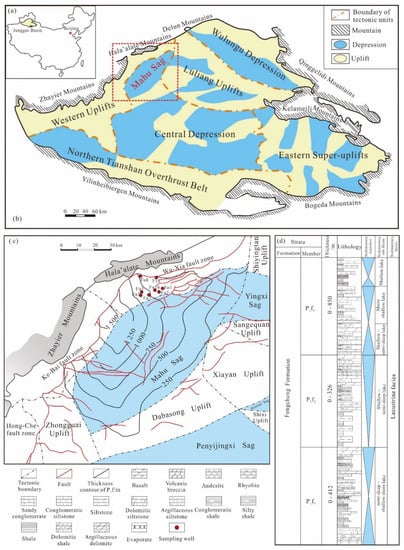
Figure 1.
(a) Map of the Junggar Basin in China. (b) The division of tectonic units in the Junggar Basin and the location of the Mahu scheme. (c) The division of sub-tectonic units and thickness contour of Fengcheng Formation in Mahu Sag. (d) Lithology and sedimentary facies profile of the Fengcheng Formation in the Mahu Sag, modified after [22].
The Mahu Sag is one of the six major hydrocarbon-generating sags in the Junggar Basin and is also the most organic-rich hydrocarbon-generating sag in the basin [13,16]. There are four sets of source rocks (Carboniferous rocks, the Jiamuhe Formation, the Fengcheng Formation, and the Permian lower Wuerhe Formation), among which the Fengcheng Formation is the main source rock, with a thickness of 50–400 m and a distribution area of approximately 3800 km2 [13,18,23]. The Fengcheng Formation is subdivided from bottom to top into the Feng 1 member (F1), Feng 2 member (F2), and Feng 3 member (F3). The salinities of the sedimentary waters and the types of sedimentary rocks are different in different members (Figure 1d). The lithology of F1 is mainly tuff and tuffaceous dolomite; F2 is mainly argillaceous dolomite and mixed rocks; and F3 is mainly tuff, argillaceous dolomite and mudstone [19]. The development and evolution of alkaline lakes in the Fengcheng Formation underwent five stages, namely, alkaline preparation, primary alkaline formation, strong alkaline formation, weak alkaline formation and termination of evolution [12,24,25], and reached the strong alkaline-forming stage in F2.
3. Samples and Methods
A total of 194 drilling core samples from 8 wells in the northwestern Mahu Sag were collected in this study, and the well location distribution is shown in Figure 1c. The test items included TOC, pyrolysis, vitrinite reflectance (Ro), biomarkers, carbon isotope ratios, chloroform bitumen “A”, and elemental analysis. All tests in this paper were completed by the Experimental and Testing Research Institute of Xinjiang Oilfield Company, China, which is a laboratory that meets the qualifications of Chinese industry certification standards.
For the analysis of TOC, the core samples were crushed until the particle size was less than 0.2 mm, hydrochloric acid solution was added to the container with the samples, and the temperature was controlled at 60–80 °C on an electric heating plate. After the dissolved samples were cleared of inorganic carbon for 2 h, the samples were washed with distilled water to neutral and dried in an oven at 60–80 °C. The Chinese national standard (GB/T 19145-2003) was implemented using a CS844 carbon sulfur analyser.
For the Rock-Eval pyrolysis analysis, the core was crushed to a particle size of 0.1 mm. Then, 100 mg samples were weighed, placed into Rock-Eval 6 equipment, heated to 300 °C and kept at a constant temperature for 3 min to measure the S1 peak, heated from 300 °C to 600 °C and kept at a constant temperature for 1 min to measure the S2 peak and Tmax value.
For Ro analysis, core samples were sliced and sintered with water and then polished and placed in a drying vessel for 12 h for reflectivity measurement. The average vitrinite reflectance under oil immersion was measured using a Leica MSP200 microphotometer under green light with magnification ranging from 32 to 125 times. At a wavelength of 546 nm, Ro was obtained according to the percentage of the reflected light intensity of the vitrinite polishing surface to the vertical incident light intensity. A standard sample whose reflectivity was close to that of the sample to be tested was selected to calibrate the instrument, and then the reflection coefficient was calibrated. The number of measured points was not less than 20, and the absolute deviation was less than 0.1.
For the extraction of chloroform bitumen and the determination of biomarker compounds, the samples were dried and crushed to 0.18 mm, and purified chloroform was added. The heating temperature was less than 85 °C, and when the extraction solution showed no fluorescence, the extraction was completed and volatilized to dry at 40 °C, and chloroform bitumen was obtained by weighing. According to the industry standard [20], 0.1 mL chloroform was added to 20 mg chloroform bitumen and completely dissolved until the chloroform volatilized; then, 30 mL n-hexane was added under constant shaking, and the solution was left to rest for 12 h to precipitate asphaltenes. When the filtrate was distilled at 80 °C and concentrated to 3 mL, it was placed into a chromatography column, and 5 mL n-hexane was eluted a total of 6 times to obtain saturated hydrocarbons. Saturated hydrocarbon components were measured on an Agilent 6890 N gas chromatograph with helium as the carrier gas, polymethylsiloxane footchain quartz capillary column with a length of 35 m and inner diameter of 0.22 mm heating from 100 °C up to 350 °C, and an electron bombardment energy of 70 ev. Ion detection was used to obtain the total ion flow chart and quality chromatograms and mass spectra compared with the standard spectra compound, peak height, and peak area.
For kerogen carbon isotope ratios, kerogen was decomposed, burned, and oxidized in a FLASH 2000 organic element analyser, converted to CO2 and collected in a sample tube. Carbon isotopic analysis was performed on a Delta V isotope ratio mass spectrometer.
For the analysis of kerogen elements, kerogen samples were burned in a high-temperature combustion tube with oxygen; the carbon and hydrogen were oxidized to CO2 and H2O, respectively; and the contents of carbon and hydrogen were calculated. The oxygen in the sample was cracked into CO at high temperature, and the oxygen content was calculated. The analysis was performed using a Vario Micro Cube elemental analyser.
4. Results
4.1. Abundance of Organic Matter
The abundance of organic matter is an important aspect to evaluate the quality of source rock. The common indicators include TOC, hydrocarbon potential generation (PG = S1 + S2), chloroform bitumen “A”, and total hydrocarbon (HC = saturated hydrocarbon plus aromatic hydrocarbon) [26,27,28]. Due to the significant difference in the organic matter abundance of source rocks of different lithologies, the higher the organic matter abundance is, the greater the potential for hydrocarbon generation is, which is an important factor affecting the quality of source rocks. Considering that the basic rock types of the source rocks of the Fengcheng Formation are argillaceous rock, dolomite, and tuff [19], the geochemical characteristics of these three types of source rocks can be clarified to make objectively evaluate the source rocks of the Fengcheng Formation.
The average values of TOC and PG of the argillaceous rocks and dolomites in the Fengcheng Formation of the Mahu Sag are similar (the dolomites have higher TOC and PG than the argillaceous rocks on the whole), while the average values of TOC and PG of tuff are significantly higher than those of the former two rock types. The content of chloroform bitumen “A” is the highest in argillaceous rocks (up to 0.465%), while it is significantly lower in tuff and dolomite than in argillaceous rocks (0.268% and 0.224%, respectively) (Table 1). From the distribution of the organic matter abundance index (Figure 2), the TOC values of argillaceous rocks were mainly distributed in the range of 0.2–1.2%, and the maximum was 2.60%. The TOC of dolomite was mostly in the range of 0.1–1.4%, and the maximum value was 2.89%. The PGs of shale and dolomite are mainly less than 4 mg/g, but the maximum value can reach over 20 mg/g. Part of the reasons for the difference in the distribution of organic matter in different lithofacies is related to the sedimentary environment. In the late period of F1, the climate was humid, and the organic-rich mudstone lithofacies was widely distributed, while in the early period of F2, the climate was dry and hot, the salinity of the lake increased, and dolomite and dolomitic rocks developed [11]. The distribution ranges and maximum values of chloroform bitumen “A” of argillaceous rock and dolomite are basically the same, but the argillaceous rocks have multipeak distribution characteristics, while the distribution of chloroform bitumen “A” in dolomite is relatively narrow, mainly less than 0.2%. Due to the small number of samples, the distribution of tuff is not representative, and its distribution range is basically consistent with those of argillaceous rocks and dolomites, but the TOC and PG are higher in tuff than in argillaceous rock or dolomite. The comparison of the organic matter abundance index of different lithologies shows that tuff is of better quality, and the content of chloroform bitumen “A” in argillaceous rock is twice as high as that in dolomite, with little difference in other parameters.

Table 1.
Geochemical characteristics of different types of source rocks in the Fengcheng Formation of the Mahu Sag.

Figure 2.
Distribution histograms of organic matter abundance in the Fengcheng Formation in the Mahu Sag. (a) Histogram of TOC distribution. (b) Histogram of PG distribution. (c) Histogram of chloroform bitumen “A” distribution.
4.2. Type of Organic Matter
Various methods can be used to identify the types of organic matter in terrestrial hydrocarbon source rocks [20]. In terms of the macerals of the parent material of hydrocarbon generation, the source rocks of the Fengcheng Formation are dominated by bacteria and algae. The bacteria are mainly cyanobacteria, and the species of algae may include dinoflagellates and amorphous matrix (Figure 3). The above characteristics indicate that the Fengcheng Formation was deposited in a saltwater lacustrine sedimentary environment. The hydrogen index (HI) and the highest pyrolysis peak temperature (Tmax) diagram (Figure 4a) show that for argillaceous rock, dolomite and tuff, most of the data points are near the type II kerogen region, with more oil-prone type II1 kerogen, and type I and III kerogen are also present. From the composition of kerogen elements in Figure 4b, dolomite mainly follows the type II kerogen evolution track, and tuff mostly approximates the type I kerogen evolution track. Lower aquatic organisms, bacteria and algae, are rich in hydrogen elements but poor in oxygen elements. Therefore, the original biological composition characteristics of hydrocarbon generating parent material reflect that the source rocks of the Fengcheng Formation are mainly sapropelic type, which is consistent with the I-II type explained by the van Krevelen diagram.
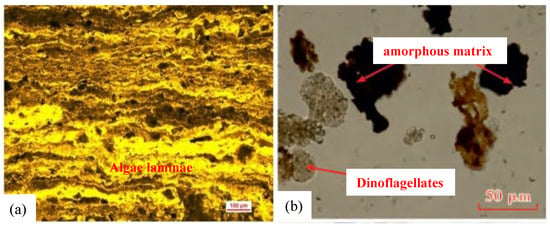
Figure 3.
Hydrocarbon-generating parent material composition of source rocks of the Fengcheng Formation in Mahu Sag. (a) Well Fn 8, 3596 m P1f, Algae laminae under UV fluorescence. (b) Well Fc 011, 3163 m P1f, Dinoflagellates and amorphous matrix under plane-polarized light.
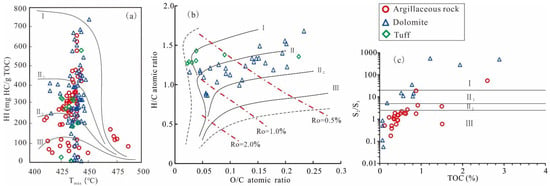
Figure 4.
Discrimination diagrams of organic matter types of source rocks in the Fengcheng Formation of the Mahu Sag. (a) Plot of Tmax versus HI. (b) Plot of H/C versus O/C atomic ratio. (c) Plot of TOC versus S2/S3.
From the relationship between the organic matter type index (S2/S3) and TOC (Figure 4c), the organic matter type improves with increasing TOC. Argillaceous rocks are mainly distributed in the type III region, but when the TOC value is greater than 1%, organic matter is mainly type II; dolomite is mainly type II and type I, and when the TOC value is greater than 1%, dolomite is mainly type I. The low values of S2/S3 observed here for the argillaceous rocks are an artefact of the matrix effect [26]. The three methods used to determine the organic matter type of the Fengcheng Formation in the Mahu Sag indicate that the organic matter was mainly oil-prone type II, followed by types I and III, indicating the diversity of organic matter sources.
4.3. Thermal Maturity of Organic Matter
Vitrinite reflectance (Ro) is the most widely used optical parameter in the determination of the rank of coals and the maturation levels of other lithologies in sedimentary basins [29,30,31]. The measured Ro in the source rocks of the Fengcheng Formation is distributed between 0.56% and 1.14%, with an average of 0.80% (Table 1), reaching the stage of mature evolution. The maturity reflected by the Tmax of argillaceous rocks, dolomites, and tuffs is basically the same, and the average value is above 435 °C, also reaching the stage of mature evolution. The maturity reflected by Ro and Tmax is consistent with that reflected by biomarker parameters C29 sterane 20S/(20S + 20R) and C29 sterane ββ/(ββ + αα) (Figure 5). The measured data show that the source rocks of the Fengcheng Formation have reached the stage of mature evolution on the whole, but a few samples are still in the stage of low maturity, and their burial depth is less than 3500 m (Figure 5).
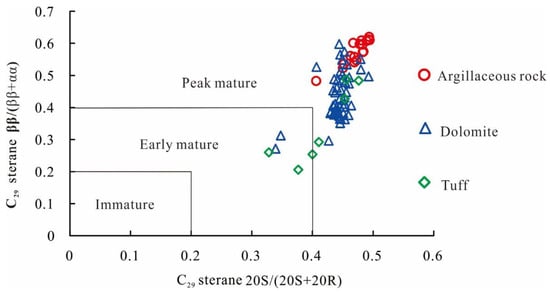
Figure 5.
Discrimination diagram of the organic matter thermal evolution degree of the Fengcheng Formation in the Mahu Sag.
Because the Ro test samples were mainly taken from the Wu-Xia fault zone and the Zhongguai Uplift adjacent to the Mahu Sag, the thickness of the Fengcheng Formation is approximately only 400 m, while the thickness of the Fengcheng Formation in the sedimentary centre of the Mahu Sag can reach 800–1800 m [10]. Therefore, the measured Ro in the Fengcheng Formation cannot reflect the overall thermal evolution degree of the Mahu Sag. For that reason, we collected the measured Ro data of Jurassic rocks, Triassic rocks, and the Permian Wuerhe Formation (P2w) from the Mahu Sag and its surrounding structural belt, and plotted their changes with depth (Figure 6). With increasing burial depth, Ro increases, and burial depth and Ro have a good correlation, indicating that the changes in Ro are mainly controlled by the normal geothermal evolution history. Thus, the Ro trend line with burial depth can be used to predict the thermal evolution history of the source rocks of the Fengcheng Formation in the Mahu Sag.
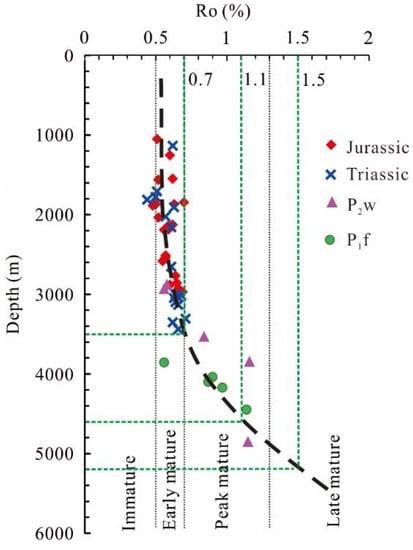
Figure 6.
Variation in Ro with depth of source rock in the Mahu Sag.
The average Ro of the 5 samples in the Fengcheng Formation is 0.89% (Table 1), and the corresponding average burial depth is 4200 m; the maximum value of Ro is 1.14%, and the corresponding burial depth is 4600 m. The burial depth of the source rocks of the Fengcheng Formation in the central area of the Mahu Sag is over 5000 m. According to the Ro evolution trend, the source rocks of the Fengcheng Formation reached the stage of high maturity (Ro > 1.3%) (Figure 6). Therefore, the thermal evolution of the hydrocarbon source rocks in the Fengcheng Formation ranges from low maturity to high maturity stage in the study area. The main pools of the Triassic Baikouquan Formation, with the Fengcheng Formation as the main source rock, are mainly composed of light to medium oil, and the density of crude oil decreases towards the centre of the Mahu Sag [13]. This result is consistent with the thermal evolution stage of source rocks of the Fengcheng Formation and provides evidence in support of the identified thermal evolution.
5. Discussion
5.1. Source Rock Evaluation Standard in Alkaline Lakes
There is no special standard for the evaluation of source rocks in alkaline lakes. The existing evaluation standard for terrestrial hydrocarbon source rocks [7,20] mainly focuses on freshwater to brackish lacustrine argillite source rocks. The source rocks of the Fengcheng Formation in the Mahu Sag are complex in lithology, so it is necessary to establish an evaluation standard suitable for alkaline lake source rocks to evaluate the hydrocarbon generation potential of the source rocks of the Fengcheng Formation in the Mahu Sag more objectively.
It is traditionally believed that although the value of TOC in source rocks of saltwater lake basins is low, its oil conversion rate is high, and the lower TOC also has a higher content of soluble organic matter, which is an important characteristic of source rocks in saltwater lake basins [7]. The source rocks of alkaline lakes in the Permian Fengcheng Formation in the Mahu Sag also have these characteristics. Although the TOC value is not high (average approximately 1.0%) in the Fengcheng Formation source rocks, the yield index S1/(S1 + S2) averages 25.9% and can reach up to 78.4% (Figure 7a). According to this study, the content of chloroform bitumen “A” increases first and then decreases with increasing TOC. When the TOC value is approximately 1.4%, the content of soluble organic matter reaches its maximum. Then, the content of soluble organic matter starts to decrease rapidly with increasing TOC, and when the TOC value is less than 0.5%, the average content of soluble organic matter is only 0.05% (Figure 7b).
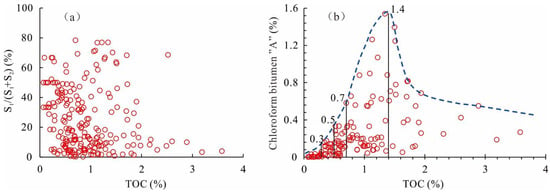
Figure 7.
(a) Relationship between TOC and productivity index S1/(S1 + S2) of source rocks in the Fengcheng Formation. (b) Relationship between TOC and chloroform bitumen “A” of source rocks in the Fengcheng Formation.
It should be pointed out that a set of effective source rocks can not only generate hydrocarbons but also discharge oil and gas. It is not an effective source rock if it can only produce hydrocarbons and cannot expel oil and gas. Theoretically, the oil and gas generated from the source rock must first meet their own adsorption and pore filling requirements, and then the excess oil and gas can be discharged in large quantities. For a source rock with a relatively homogeneous parent material type and thermal evolution degree, the higher the total organic matter content in the source rock before hydrocarbon expulsion, the more oil and gas will be generated. When the organic matter content reaches a certain critical value, oil and gas are discharged from a large number of source rocks; at this time, with the increase in the TOC of source rocks, their residual hydrocarbon content will deviate from the normal trend and decrease. The critical value is the limit value for a large quantity of hydrocarbon to be expelled from source rock and can be used as the lower limit value of excellent source rock. Chloroform bitumen “A” is usually used to represent the mass fraction of soluble organic matter in rocks, and the TOC content represents the mass fraction of organic matter in rocks. According to the relationship between the two, the lower limit of TOC in excellent source rocks of the Fengcheng Formation in the Mahu Sag can be determined to be 1.4% (Figure 7b).
The hydrocarbon generation potential of source rocks, from the perspective of organic geochemistry, mainly depends on the abundance, type, and maturity of organic matter, and the three are complementary. It is well known that source rocks with a high abundance of organic matter, type I or II1 organic matter and moderate maturity have great petroleum generation potential. The abundance and types of organic matter are closely related to the sedimentary environment. For example, the semi-deep to deep lake facies belt in the continental basin is dominated by organic matter-rich sapropel, while the shallow lake-shore facies belt and fluvial facies are dominated by organic matter-poor humus [7]. Therefore, the establishment of an evaluation standard for hydrocarbon source rocks in alkaline lakes of the Fengcheng Formation in the Mahu Sag is based on the classification of the types of organic matter types in hydrocarbon source rocks. The hydrocarbon source rocks in the Fengcheng Formation are mostly type II, with some type I and type III. As shown in Figure 3a, which shows the relationship between Tmax and HI, the main peak of Tmax is 440 °C. The corresponding relationship between different types of organic matter and hydrogen index values is as follows: type I organic matter with HI greater than 400 mg/g, type II1 organic matter with HI of 200–400 mg/g, type II2 with HI of 100–200 mg/g, and type III with HI less than 100 mg/g.
In the TOC and HI diagram (Figure 8a), the limits of HI can be divided into five sections depending on the type of organic matter. When the TOC content is less than 1%, TOC and HI have a positive relationship. The mean value of the corresponding TOC content in each HI interval is taken as the TOC limit of different grades; accordingly, the TOC limit value of non-source rocks was determined to be 0.3%, that of poor source rocks to be 0.3–0.5%, and that of fair source rocks to be 0.5–0.7%. When the TOC content is greater than 1.4%, the organic matter is type I, and the rocks are composed of excellent hydrocarbon source rocks; the range of 0.7–1.4% is representative of good source rocks. Subsequently, the source rock evaluation standards (Table 2) were established according to the series of relationship diagrams of TOC and PG (Figure 8b), TOC and chloroform bitumen “A” (Figure 7b), TOC and chloroform bitumen “A”/TOC (Figure 8c), and chloroform bitumen “A” and HC (Figure 8d).
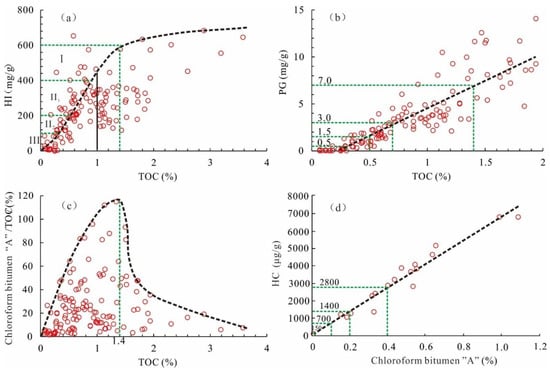
Figure 8.
Limit chart of source rock evaluation indexes of the Fengcheng Formation in the Mahu Sag. (a) Plot of TOC versus HI. (b) Plot of TOC versus PG. (c) Plot of TOC versus chloroform bitumen “A”. (d) Plot of chloroform bitumen “A” versus HC.

Table 2.
Evaluation standard of continental alkaline lake source rock.
Compared with the traditional TOC evaluation indicator of terrestrial freshwater-brackish water source rocks (Table 3), the TOC thresholds of different grades in alkaline lake source rocks were significantly lower than those in the freshwater-brackish water standard, and the higher the grade was, the greater the gap between the two. Compared with the TOC of the source rocks of brackish water and ultrabrackish water [20], the standard of the source rocks of alkaline lakes is slightly higher than the TOC of brackish water and ultrabrackish water at all levels, except for the medium level. At the level of good to very good (high-quality) source rock, the standard alkaline lake source rock has approximately twice the TOC of saltwater to super saltwater. These results also reflect that the organic matter abundance of alkaline lake source rocks is higher than that of non-alkaline lake source rocks in continental saline lake basins. In addition to the TOC, compared with other hydrocarbon source rock organic matter abundance indicators, such as chloroform bitumen “A”, HC and PG, in a set of standards used for the geochemical evaluation of continental hydrocarbon source rock [20] developed by the Communist Party of China, the chloroform bitumen “A” and HC values of alkaline lakes are approximately double those of non-alkaline lakes, and the PG of alkaline lakes is approximately half that of non-alkaline lakes. Due to the high organic matter conversion rate of hydrocarbon source rocks in alkaline lakes, the new standard also takes the organic matter conversion rate as an auxiliary index in the evaluation of source rocks.

Table 3.
Evaluation index of organic matter abundance of terrestrial source rocks [20].
5.2. Evaluation of Hydrocarbon Source Rocks in Alkaline Lakes
According to the newly established hydrocarbon source rock evaluation standard of alkaline lakes, the source rocks of the Fengcheng Formation in the Mahu Sag are mainly good to excellent source rocks, accounting for 55.5% of the total samples, among which the excellent source rocks account for 16.1%. Fair source rocks accounted for 20.6% of the total samples. The rest were poor and non-source rocks (23.9%). According to the traditional evaluation standard of saltwater lacustrine source rocks, the percentage of source rocks in the Fengcheng Formation is 64.7%, and the percentage of excellent source rocks is 48.6%. Compared with the traditional evaluation standard for lacustrine source rocks, the new standard for evaluating hydrocarbon source rocks of alkaline lakes focuses more on the characteristics of hydrocarbon expulsion of excellent-level source rocks, in which the organic carbon content is greater than 1.4% and the content of chloroform bitumen “A” is sharply reduced, indicating rapid and large-scale hydrocarbon expulsion. Therefore, in the hydrocarbon source rock evaluation, this part of the source rock is relatively small, but these excellent-level, high-quality hydrocarbon source rocks should be considered. In addition, in recent years, source rocks with high organic matter abundance have often been found in the centre of non-alkaline saltwater lake basins during oil and gas exploration [6,9], confirming that the organic matter abundance of source rocks in these saltwater lake basins is not as low as previously thought [32,33]. Therefore, this standard is not only applicable to the classification and evaluation of terrestrial alkaline lake source rocks but also has important reference value for the evaluation of nonalkaline lake and saltwater basin source rocks. Notably, no hydrocarbon source rock samples have been obtained in the sedimentary centre of the Mahu Sag, and most of the existing samples are from relatively high structural positions around the edge of the sag, so the characteristics of the source rock in the sag centre are not clear. It is speculated that the organic matter in the depression centre has higher abundance, better types, and higher evolutionary maturity [34].
5.3. Hydrocarbon Generation Model in Alkaline Lake Source Rocks
5.3.1. Source Rock Thermal Simulation Method
The process of depositing organic matter underground to generate oil and gas is long and complex and is accompanied by a series of physicochemical and biochemical processes [35,36]. Since Tissot et al. [36] confirmed the dominant roles of temperature and time in the hydrocarbon generation process of organic matter and the complementary relationship between them, a variety of experimental methods have emerged to simulate the hydrocarbon generation process of organic matter by means of rapid heating. The principle is to compensate for the effect of time on organic hydrocarbon generation by rapidly increasing the experimental temperature to approach the effect of actual geological conditions.
Ma et al. [37] established a hydrocarbon generation model of the source rock of the Permian Fengcheng Formation in the Junggar Basin (Figure 9) by using the experimental method of high-pressure kettle water addition simulation. It was proposed that Ro was 0.7–1.5% at the main oil generation stage; when Ro of 1.0% was the peak, the maximum oil generation was 220 mg/g TOC. When Ro reaches approximately 2.5%, the peak of gas production is reached, which is mainly crude pyrolysis gas. Pan et al. [38] studied samples from the FN 1 well in the Fengcheng Formation (the burial depth is 4096.44 m, TOC is 1.82%, hydrocarbon yield is 506 mg/g TOC, Tmax is 440 °C) as an example, and their simulation showed that when Ro was 1.0% at the peak oil source, the maximum oil generation was 300 mg/g TOC, Ro was still in a large oil generation stage when it was 1.5%, and Ro corresponding to the gas peak was 2.3%. The thermal simulation results show that the source rocks of the Fengcheng Formation have the characteristics of continuous oil generation, and a one-stage oil peak and large hydrocarbon generation occur.
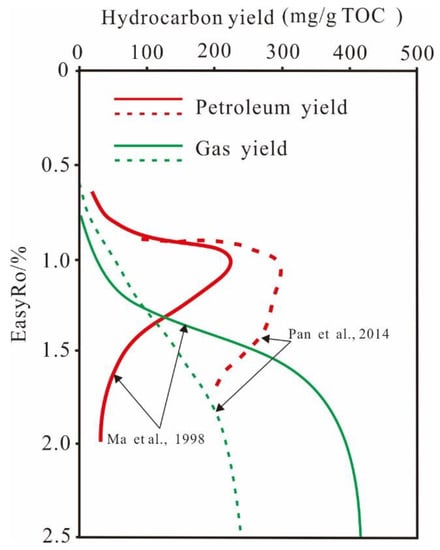
Figure 9.
Comparison of hydrocarbon generation models of source rocks in the Permian Fengcheng Formation [37,38].
5.3.2. Measured Profile Method
The geochemical indexes to measure the degree of conversion of insoluble organic matter kerogen to soluble organic matter (hydrocarbons) mainly include S1/TOC, S1/(S1 + S2), chloroform bitumen “A”/TOC, and HC/TOC. According to the measured data of hydrocarbon source rocks in the Fengcheng Formation, Mahu Sag, in this study, the oil generation threshold and the hydrocarbon generation peak are determined mainly based on changes in the S1/TOC and chloroform bitumen “A”/TOC relationship with burial depth, and then the oil generation threshold and the Ro value corresponding to the peak are determined through the relationship between Ro and burial depth.
According to the analysis of S1/TOC and chloroform bitumen “A”/TOC with burial depth, the natural profile of the hydrocarbon generation rate of source rocks was established, which provided the basis for analysing the hydrocarbon generation capacity and model of the source rocks of the Fengcheng Formation (Figure 10). The results show that there is a main peak of hydrocarbon generation in the source rock of the Fengcheng Formation, and the burial depth corresponding to the main peak is approximately 4600 m, which is in good agreement with the thermal simulation of the hydrocarbon generation curve of the source rock (Figure 10a,b). When the burial depth of the source rock reaches 3500 m, it enters the threshold of oil generation; the burial depth of 5200 m is the bottom depth of liquid hydrocarbons. According to the relationship between Ro and burial depth (Figure 6), Ro is 0.7%, 1.1% and 1.5% for burial depths of 3500 m, 4600 m, and 5200 m in the Fengcheng Formation, respectively (Figure 10b).
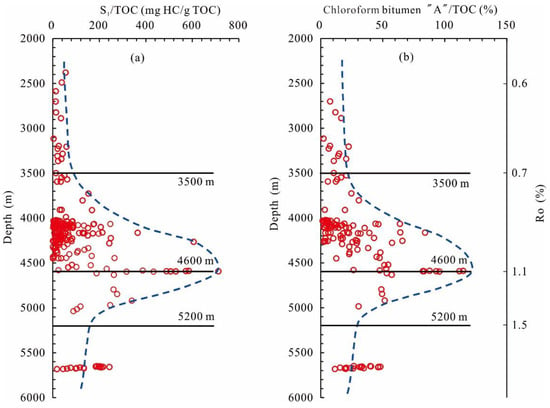
Figure 10.
Relationship between hydrocarbon generation conversion rate and burial depth of source rocks in the Fengcheng Formation, Mahu Sag. (a) S1/TOC varies with depth and Ro to determine the main oil generation stage. (b) Chloroform bitumen “A”/TOC varies with depth and Ro to determine the main oil generation stage.
The comparison of hydrocarbon generation patterns between the source rocks of the Fengcheng Formation in the Mahu Sag and those in other sedimentary environments shows that the single-peak hydrocarbon generation patterns are not only consistent with the traditional high-quality source rocks of lacustrine facies [7] but also similar to the single-peak oil generation characteristics of other source rocks of saltwater basins in China [32,39,40,41].
5.3.3. Comprehensive Model of Hydrocarbon Generation
Based on the thermal simulation experiment of hydrocarbon generation in source rocks and the comprehensive analysis of natural profiles, the relationships between the hydrocarbon generation conversion rate and burial depth of source rocks with various salinities and ages in different basins and lake basins in China were compared [7,42,43,44] to reconsider the hydrocarbon generation process of the hydrocarbon source rock of alkaline lakes in the Permian Fengcheng Formation, Mahu Sag. According to the mechanism of hydrocarbon generation, the characteristics of the main hydrocarbon generation products and the diagenetic stage, the hydrocarbon generation process can be divided into four stages (Figure 11).
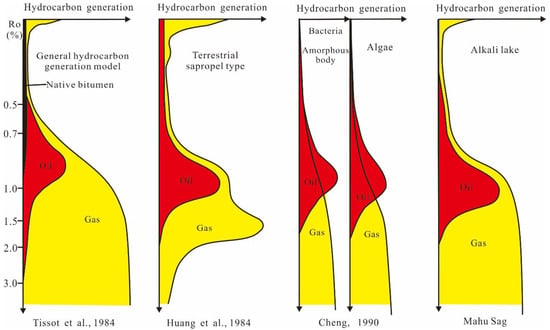
Figure 11.
Comparison of hydrocarbon generation models between source rocks and alkaline lake source rocks in continental freshwater lake basins [36,42].
The first stage occurred in the period of early diagenesis, with Ro less than 0.7% and burial depth less than 3500 m, indicating an immature to low-maturity evolution stage. The crude oil generated at this stage has a high density and high viscosity. Due to the relatively small amount of crude oil produced, it has not yet met the requirements of kerogen adsorption and pore filling, so it is mainly confined within the source rocks of the Fengcheng Formation.
The second stage occurred in the early stage of catagenesis, with Ro of 0.7–1.3% and burial depths of 3500–5000 m in the slope area, indicating a mature evolution stage. The main peak Ro of crude oil is 0.85–1.3%, which is the main period of petroleum generation. When Ro reaches approximately 1.1%, it reaches the peak of crude oil generation, and then the amount of liquid hydrocarbon generation gradually decreases. In addition to the main formation of mature crude oil, a small amount of thermogenic gas can be generated at this stage, which exists underground and can dissolve in the crude oil, reducing the density and viscosity of the crude oil and facilitating the migration of hydrocarbons.
The third stage occurred in the late stage of catagenesis. Ro was 1.3–2.0%, and the burial depth was 5000–6000 m. This was a stage of high maturity evolution. The hydrocarbon generation products at this stage are mainly light oil and wet gas, natural gas is mainly caused by kerogen thermal degradation, and the second most abundant hydrocarbon generation product is heavy hydrocarbon gas formed by crude oil cracking.
The fourth stage occurred in metagenesis, with Ro greater than 2.0% and burial depth greater than 6000 m. This stage involved overmature evolution, and the bottom of the source rock of the Fengcheng Formation did not reach this stage of evolution. The main product of this stage, which is the main stage of natural gas formation, is the dry methane formed by crude oil cracking.
The source rocks of the Permian Fengcheng Formation in the Mahu Sag show the characteristics of continuous hydrocarbon generation and large hydrocarbon production. The source rocks of the Permian Fengcheng Formation in the Mahu Sag have hydrocarbon generation characteristics and models similar to those of the common freshwater and saltwater lacustrine facies, but their hydrocarbon generation conversion is significantly higher than that of the latter, which is 2–5 times that of the traditional freshwater brackish and saltwater lacustrine facies (Table 4).

Table 4.
Organic matter transformation of source rocks in continental freshwater-brackish lake basins, China.
6. Conclusions
The source rock of the Fengcheng Formation in the Mahu Sag, Junggar Basin, is mainly argillaceous rock and dolomite with TOC contents of 0.82% and 0.86%, respectively. The source rocks contain organic matter types I~III and are mainly oil-prone type II1. The slope area is in the mature evolution stage, and the centre of the depression has reached the high maturity evolution stage. Based on the classification of organic matter types, the relationship between TOC and chloroform bitumen “A”, and the relationships between major geochemical parameters, the evaluation standard for five parameters of alkaline lake source rock was established. TOC > 0.7% indicates a good to excellent source rock, and the Fengcheng Formation is dominated by high-quality source rock. Hydrocarbon source rocks in the Fengcheng Formation have similar characteristics and patterns of hydrocarbon generation to those in traditional freshwater and saltwater lake basins, with slight lags in the source peak, Ro of 1.1%, a period of continuous hydrocarbon generation and characteristics of the production of large quantities of hydrocarbons. The advantages of the alkaline lake hydrocarbon generation model are that fungal algae are the main hydrocarbon generation materials in naphthenic base crude oil, and the hydrocarbon generation production rate in the new model is twice as high as that estimate using the traditional model.
Author Contributions
Conceptualization, Y.B. and J.Z.; methodology, S.Y. and Y.Z.; software, W.H.; formal analysis, X.Z.; investigation, W.W. and H.W.; data curation, W.H.; writing—original draft preparation, Y.T. and Y.B.; writing—review and editing, J.Z.; visualization, Y.B.; supervision, J.Z.; project administration, W.H. All authors have read and agreed to the published version of the manuscript.
Funding
This research was funded by the National Science and Technology Major Project, grant number 2017ZX05001-004.
Data Availability Statement
Not applicable.
Conflicts of Interest
The authors declare no conflict of interest.
References
- Melack, J.M.; Peter, K. Photosynthetic rates of phytoplankton in East African alkaline, saline lakes. Limnol. Oceanogr. 1974, 19, 743–755. [Google Scholar] [CrossRef]
- Kelts, K. Environments of deposition of lacustrine petroleum source rocks: An introduction. In Lacustrine Petroleum Source Rocks; Fleet, A.J., Kelts, K., Talbot, M.R., Eds.; Geological Society Special Publication: London, UK, 1988; Volume 40, pp. 3–29. [Google Scholar]
- Sun, Z.C.; Yang, F.; Zhang, Z.H. Sedimentary Environments and Hydrocarbon Generation of Cenozoic Salified Lakes in China; Petroleum Industry Press: Beijing, China, 1997; pp. 1–187. [Google Scholar]
- Zhu, G.Y.; Jin, Q.; Dai, J.X. Investigation on the salt lake source rocks for middle Shasi column of Dongying Depression. Geol. J. China Univ. 2004, 10, 257–266. [Google Scholar]
- Li, G.S.; Wang, Y.B.; Lu, Z.S. Geobiological processes of the formation of lacustrine source rock in Paleogene. Sci. China Earth Sci. 2014, 44, 1206–1217. [Google Scholar] [CrossRef]
- Jin, Q.; Zhu, G.Y.; Wang, J. Deposition and distribution of high-potential source rocks in saline lacustrine environments. J. China Univ. Pet. 2008, 32, 19–23. [Google Scholar]
- Hu, J.Y.; Hang, D.F. The Bases of Nonmarine Petroleum Geology in China; Petroleum Industry Press: Beijing, China, 1991; pp. 1–152. [Google Scholar]
- Dong, T.; He, S.; Lin, S.Q. Organic geochemical characteristics and thermal evolution maturity history modeling of source rocks in Eocene Hetaoyuan Formation of Biyang Sag, Nanxiang Basin. Exp. Pet. Geol. 2013, 37, 499–506. [Google Scholar]
- Li, S.F.; Hu, S.Z.; Sun, Y.M. Analysis and Comprehensive Evaluation of Source Rock Characteristics in Hydrocarbon Rich Depressions in Eastern China; China University of Geosciences Press: Wuhan, China, 2016; pp. 1–85. [Google Scholar]
- Qin, Z.Z.; Chen, L.H.; Li, Y.W. Paleo-sedimentary setting of the Lower Permian Fengcheng alkali lake in Mahu Sag, Junggar Basin. Xinjiang Pet. Geol. 2016, 37, 1–6. [Google Scholar]
- Zhang, Z.J.; Yuan, X.J.; Wang, M.S. Alkaline-lacustrine deposition and Paleoenvironmental evolution in Permian Fengcheng Formation at the Mahu Sag, Junggar Basin, NW China. Petrol. Explor. Dev. 2018, 45, 972–984. [Google Scholar] [CrossRef]
- Cao, J.; Xia, L.W.; Wang, T.T. An alkaline lake in the Late Paleozoic Ice Age (LPIA): A review and new insights into paleoenvironment and petroleum geology. Earth Sci. Rev. 2020, 202, 781–790. [Google Scholar] [CrossRef]
- Lei, D.W.; Chen, G.Q.; Liu, H.L. Study on the forming conditions and exploration fields of the Mahu giant oil (gas) Province, Junggar Basin. Acta Geol. Sin. 2017, 91, 1604–1619. [Google Scholar]
- Wang, X.L.; Zhi, D.M.; Wang, Y.T. Source Rocks and Oil-Gas Geochemistry in Junggar Basin; Petroleum Industry Press: Beijing, China, 2013; pp. 1–154. [Google Scholar]
- Chen, J.P.; Wang, X.L.; Deng, C.P. Geochemical features of source rocks and crude oil in the Junggar Basin, Northwest China. Acta Petrol. Sin. 2016, 90, 37–67. [Google Scholar]
- Zhi, D.M.; Cao, J.; Xiang, B.L. Fengcheng alkaline lacustrine source rocks of lower Permian in Mahu Sag in Junggar Basin: Hydrocarbon generation mechanism and petroleum resources reestimation. Xinjiang Pet. Geol. 2016, 37, 499–506. [Google Scholar]
- Tang, Y.; Guo, W.J.; Wang, X.T. A new breakthrough in exploration of large conglomerate oil province in Mahu Sag and its implications. Xinjiang Pet. Geol. 2019, 40, 127–137. [Google Scholar]
- Wang, X.J.; Wang, T.T.; Cao, J. Basic characteristics and highly efficient hydrocarbon generation of alkaline⁃lacustrine source rocks in Fengcheng Formation of Mahu Sag. Xinjiang Pet. Geol. 2018, 39, 9–15. [Google Scholar]
- Ren, J.L.; Jin, J.; Ma, W.Y. Analysis of hydrocarbon potential of Fengcheng saline lacustrine source rock of Lower Permian in Mahu Sag, Junggar Basin. Geol. Rev. 2017, 63, 51–52. [Google Scholar]
- Huang, F.; Xin, M.A. Geochemical Evaluation Method of Nonmarine Source Rocks; China National Petroleum Corporation: Beijing, China, 1995; pp. 1–10. [Google Scholar]
- Qin, J.Z.; Liu, B.Q.; Guo, J.Y. Discussion on the evaluation standards of carbonate source rocks. Exp. Pet. Geol. 2004, 26, 281–285. [Google Scholar]
- Zhi, D.M.; Tang, Y.; He, W.J. Orderly coexistence and accumulation models of conventional and unconventional hydrocarbons in Lower Permian Fengcheng Formation, Mahu sag, Junggar Basin. Petrol. Explor. Dev. 2021, 48, 43–59. [Google Scholar] [CrossRef]
- Kuang, L.C.; Tang, Y.; Le, D.W. Exploration of fan-controlled large-area lithologic oil reservoirs of Triassic Baikouquan Formation in slope zone of Mahu Depression in Junggar Basin. China Pet. Explor. 2014, 19, 14–23. [Google Scholar]
- Zheng, M.P. On saline lakes of China. Mineral. Depos. 2001, 20, 181–189. [Google Scholar]
- Tao, K.Y.; Cao, J.; Chen, X. Deep hydrocarbons in the northwestern Junggar Basin (NW China): Geochemistry, origin, and implications for the oil vs. gas generation potential of post-mature saline lacustrine source rocks. Mar. Pet. Geol. 2019, 109, 623–640. [Google Scholar] [CrossRef]
- Espitalié, J.; Makadi, K.S.; Trichet, J. Role of the mineral matrix during kerogen pyrolysis. Org. Geochem. 1984, 6, 365–382. [Google Scholar] [CrossRef]
- Sorci, A.; Cirilli, S.; Clayton, G.; Corrado, S.; Hints, O.; Goodhue, R.; Schito, A.; Spina, A. Palynomorph optical analyses for thermal maturity assessment of Upper Ordovician (Katian-Hirnantian) rocks from Southern Estonia. Mar. Petrol. Geol. 2020, 120, 104574. [Google Scholar] [CrossRef]
- Yang, S.; Horsfield, B. Critical review of the uncertainty of Tmax in revealing the thermal maturity of organic matter in sedimentary rocks. Int. J. Coal. Geol. 2020, 225, 103500. [Google Scholar] [CrossRef]
- Suarez-Ruiz, I.; Flores, D.; Mendonca Filho, J.G.; Hackley, P.C. Review and update of the applications of organic petrology: Part 1, geological applications. Int. J. Coal. Geol. 2012, 99, 54–112. [Google Scholar] [CrossRef]
- Fernandes, P.; Cogné, N.; Chew, D.M.; Rodrigues, B.; Jorge, R.C.; Marques, J.; Vasconcelos, L. The thermal history of the Karoo Moatize-Minjova Basin, Tete Province, Mozambique: An integrated vitrinite reflectance and apatite fission track thermochronology study. J. Afr. Earth Sci. 2015, 112, 55–72. [Google Scholar] [CrossRef]
- Spina, A.; Vecoli, M.; Riboulleau, A.; Clayton, G.; Cirilli, S.; Di Michele, A.; Marcogiuseppe, A.; Rettori, R.; Sassi, P.; Servais, T.; et al. Application of Palynomorph Darkness Index (PDI) to assess the thermal maturity of palynomorphs: A case study from North Africa. Int. J. Coal. Geol. 2018, 188, 64–78. [Google Scholar] [CrossRef]
- Zhang, B.; He, Y.Y.; Chen, Y. Geochemical characteristics and oil accumulation significance of the high quality saline lacustrine source rocks in the western Qaidam Basin, NW Chin. Acta Petrol. Sin. 2017, 38, 1158–1167. [Google Scholar]
- Liu, C.L.; Li, J.; Guo, Z.Q. Geochemical Characteristics of Source Rocks and Hydrocarbon Accumulation Mechanism in the Salt Lake Basin; Science Press: Beijing, China, 2018; pp. 1–187. [Google Scholar]
- Cao, J.; Lei, D.W.; Li, Y.W. Ancient high-quality alkaline lacustrine source rocks discovered in the Lower Permian Fengcheng Formation, Junggar Basin. Acta Petrol. Sin. 2015, 36, 781–790. [Google Scholar]
- Hunt, J. Petroleum Geochemistry and Geology; W H Freeman and Company: NewYork, NY, USA, 1979; pp. 67–178. [Google Scholar]
- Tissot, B.P.; Welte, D.H. Petroleum Formation and Occurrence; Spring: Berlin/Heidelberg, Germany, 1984; pp. 1–189. [Google Scholar]
- Ma, Z.; Ning, S.H.; Jiang, L. Hydrocarbon generation model of source rock in Junggar Basin. Xinjiang Pet. Geol. 1998, 19, 278–280. [Google Scholar]
- Pan, C.C.; Gao, X.W.; Xiang, B.L. Study on the Dynamic Characteristics of Hydrocarbon Generation in Different Types of Source Rocks; Experimental Detection Research Institute of PetroChina Xinjiang Oilfield Company: Kelamayi, China, 2014; pp. 1–125. [Google Scholar]
- Zhu, S.A.; Xu, S.R.; Zhu, S.B. Petroleum geological characteristics of the Biyang Depression, Henan. Acta Petrol. Sin. 1981, 2, 21–27. [Google Scholar]
- Jiang, J.G. Origin of oil and gas in Qianjiang Formation of saline lake facies in the Jianghan Basin. Acta Petrol. Sin. 1981, 2, 83–92. [Google Scholar]
- Ma, X.M.; Wang, J.G.; Shi, Y.J. Paleogene high abundance hydrocarbon source rocks, the soul of oil rich depression in Southwestern Qaidam Basin. Geol. Sci. Technol. Inf. 2018, 37, 96–104. [Google Scholar]
- Huang, D.F.; Li, J.C.; Zhou, Z. Evolution and Hydrocarbon Generation Mechanism of Continental Organic Matter; Petroleum Industry Press: Beijing, China, 1984; pp. 1–255. [Google Scholar]
- Jiang, J.G.; Zhang, Q. The generation and evolution of petroleum of the saline Qianjiang Formation in Jianghan Basin. Oil Gas. Geol. 1982, 3, 1–15. [Google Scholar]
- Zhao, C.Y.; Cheng, K.M.; Wang, F.Y. Analyses of the macerals contributing mainly to hydrocarbons derived from coals of the Turpan-Hami Basin. Acta Sedimentol. Sin. 1997, 15, 95–99. [Google Scholar]
- Chen, J.; Lu, K.; Feng, Y. Evaluation on hydrocarbon source rocks in different environments and characteristics of hydrocarbon generation and expulsion in Dongpu Depression. Fault Block Oil Gas. Field 2012, 19, 35–38. [Google Scholar]
- Fu, S.T.; Ma, D.D.; Chen, Y. New advance of petroleum and gas exploration in Qaidam Basin. Acta Petrol. Sin. 2016, 37, 1–10. [Google Scholar]
- Yang, H.; Zhang, W.Z. Leading effect of the Seven Member high-quality source rock of Yanchang Formation in Ordos Basin during the enrichment of low-penetrating oil-gas accumulation: Geology and geochemistry. Geochimica 2005, 34, 147–154. [Google Scholar]
- Fu, J.H.; Li, S.X.; Xu, L.M. Paleo-sedimentary environmental restoration and its significance of Chang 7 Member of Triassic Yanchang Formation in Ordos Basin, NW China. Petrol. Explor. Dev. 2018, 45, 936–946. [Google Scholar] [CrossRef]
- Hou, Q.J.; Feng, Z.Q.; Feng, Z.H. Nonmarine Petroleum Geology of Songliao Basin; Petroleum Industry Press: Beijing, China, 2009; pp. 1–358. [Google Scholar]
Publisher’s Note: MDPI stays neutral with regard to jurisdictional claims in published maps and institutional affiliations. |
© 2021 by the authors. Licensee MDPI, Basel, Switzerland. This article is an open access article distributed under the terms and conditions of the Creative Commons Attribution (CC BY) license (https://creativecommons.org/licenses/by/4.0/).